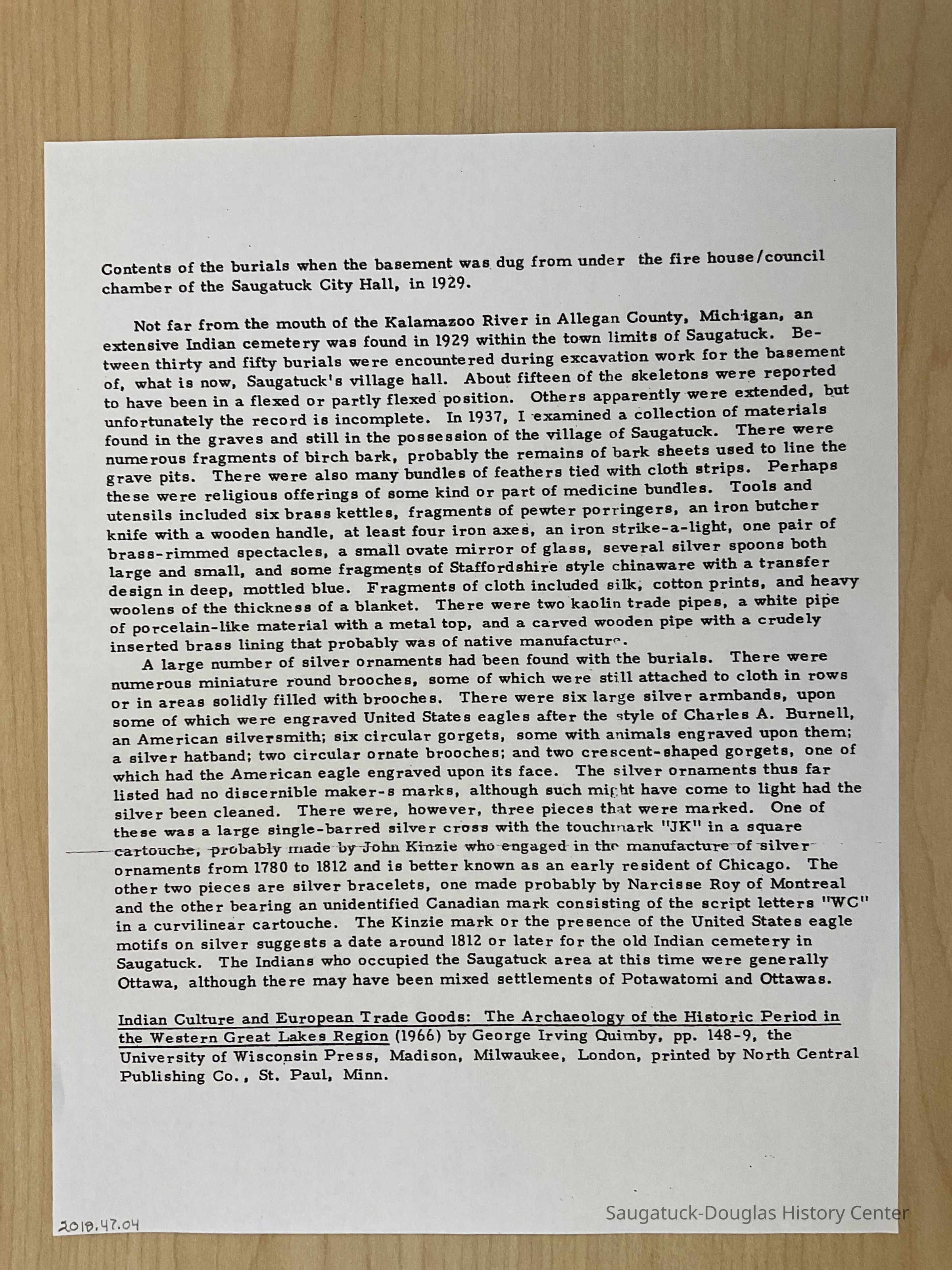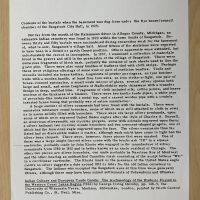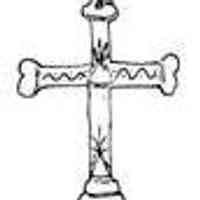Contents of Saugatuck Burial Site

2018.47.04
This Native American burial, what happened to its contents is a irritating mystery. See 2023.10.49 for a newspaper clipping that shows some items from the burial [warning] including human remains.
Cemeteries and graves0001 Anishinabek/Ojibwe/Odawa/Bodéwadmi
Voss, Mary
2018.47
Found in the SDHS/SDHC collection
Donation
Native American CultureSaugatuck City Hall Native Burial Site
Quimby, George Irving Jr. 1913-2003
Early Create Date: 1966
Files Accession Number
Quimby, George Irving Jr. 1913-2003102 Butler/Saugatuck Village Hall
Status: OK Status By: Mary Voss Status Date: 2018-10-15
SDHS insert pgs 465-468 (During study of a possible archeology site near old Singapore, State Archeologist John R. Halsey, unearthed an old paper written in the winter of 1937 by then graduate student George I. Quimby describing Indian artifacts found in downtown Saugatuck.) All HISTORIC BURIAL SITE AT SAUGATUCK, MICHIGAN While excavating for the foundations of the city hall at Saugatuck, Michigan, an extensive burial site (historic) was discovered. This site is on the sandy river flat not far from the present course of the Kalamazoo River - about 500 feet. According to the Town Marshall, at least thirty skeletons were disturbed in the building operations. Some of this material is now displayed in the second floor of the town hall, among which are the following objects. 1. One large complex single-barred silver cross with the touchmark JK in a square cartouche. 2. Six silver armbands, some of which have engraved upon the face an American eagle (United States Arms). 3. Six medium-sized to large circular silver gorgets, some of which have animals engraved upon their faces. Not having been sufficiently cleaned, touchmarks, if present, were not discernible. 4. Two crescent-shaped silver gorgets, not marked. One has engraved upon it the United States eagle. 5. Two silver bracelets. One bears a touchmark consisting of the script letters "WC" in a complex curvilinear cartouche. The other is stamped with the script letters NR in a complex curvilinear cartouche. 6. Two circular ornate brooches, mark if air not visible due to patination. 7. One silver headband, unmarked.. 8. Fragments of pewter utensils 9. Six copper kettles in poor condition. 10. Two white-clay trade pipes 11. One white porcelain pipe with a metal top. 12. One carved wood pipe with a crude copper lining. Possibly this is of native manufacture. 13. One small ovate glass mirror. 14. One pair of braes rimmed spectacles. 15. One iron strike-a-light. 16. One iron knife with a wood handle. 17. Four or more iron axes of various types. None, however, are so-called tomahawks. 18. Several teaspoons and tablespoons, possibly silver. 19. Numerous fragments of birch bark, well-preserved. 20. Numerous bundles of feathers tied with woven cloth stripe. 21. Numerous miniature round brooches, some of which are still fastened to cloth. 22. Fragments of cloth, both light (such as silk and cotton) and heavy (such as wool broadcloth). 23. Several fragments of deep blue Staffordshire type china. 24. Two skulls, both of which are roundheaded and very likely would fit into the cephalic index range of all previously described and measured skulls definitely ascribed to the historic period in Michigan. The presence of the baited States eagle engraved upon some of the silver ornaments and the seeming lack of Montreal or other British touchmarks, suggests that the silver was manufactured in and distributed by traders or agents of the United States. Since previous studies, although Incomplete, have indicated that the British had a monopoly upon the Indian trade and Indian allegiance from about 1780 to ,HIS, it is possible that this site, with its abundance of United States silver, is of a later date. This thesis is in part substantiated by the presence of the well-preserved fragments of birchbark and the feathers. The Staffordshire type china was probably manufactured after 1795 . Future identification of the several touchmarks will, perhaps, settle the question. In a later book, Indian Culture and European Trade Goods (The University of Wisconsin Press: Madison, Wisconsin) 1966, Quimby elaborated slightly. He noted that the cemetery had been discovered in 1929 "within the town limits of Saugatuck." Between 30 and 50 burials were encountered during excavation work for the construction of a new community hall. About I S of the skeletons were reported to have been in a flexed or partly flexed position. Others apparently were extended, but unfortunately the record is incomplete. In 1937, I examined a collection of materials found in the graves and still in possession of the city of Saugatuck. He revised his analysis of item number one, ... the large single-barred silver cross with the touchmark "JK" in a square cartouche, probably made by John Kinzie who engaged in the manufacture of silver ornaments from 1780 to 1 812 and is better known as an early resident of Chicago... The Kinzie mark on silver suggests a date around 1812 or later for the old Indian cemetery in Saugatuck. the Indians who occupied the Saugatuck area at this time were generally Ottawa, although there may have been mixed settlements of Potawatomi and Ottawa. Interestingly J. H. Kinzie of Chicago is listed in an 1838 letter written by Saugatuck founder William G. Butler as "one of the proprietors of land on the oxbow or warehouse fraction which is expected to be connected by a ship canal." The projected canal would have cut a path along the present road to Ox-Bow providing a more direct access to Lake Michigan from downtown Saugatuck. George Irving Quimby was born May 4, 1913, in Grand Rapids, Michigan. Both of his parents were greatly intrigued by history, especially that of local Indians. Quimby graduated from Central High School in the spring of 1932 and started college at the University of Michigan later that year. He afterwards attended the University of Chicago's graduate program in anthropology and was a student in Chicago when he visited Saugatuck and inspected the artifacts, writing a paper for a class with C. E. Guthe. Before completing the graduate program he left to go to Louisiana and work under Jim Ford. While in Louisiana he met art student Helen Ziehm. The couple was married in the fall of 1940. Quimby returned to Michigan and became the director of the Muskegon Museum. Two years later he accepted a position as the chair of the anthropology department at the Field Museum of Natural History in Chicago where he remained for the next 13 years. In 1965 he became professor of anthropology at the University of Washington, leaving three years afterwards to become director of the Thomas Burke Memorial Washington State Museum. He died in 2003. ** * The bones which were found in the burial grounds were gathered together and reinterred beneath a small mound of earth near the southwest intersection of Butler and Culver Streets across from the Village Hall. Nearby a stone "to the memory of the old Indian burying ground..." was dedicated with ceremony at the 1930 celebration of the centennial of Saugatuck. Johnson Fox, then just a boy, remembers being the one who actually spoke the words of dedication dressed in an Indian outfit made by his mother. The burial mound was leveled during street widening in the 1970s, and for a few years only the curved sidewalk which had gone around the mound showed its former position. Eventually even that was removed, although the memorial rock remains. The artifacts on the second floor of the Saugatuck Village Hall were on display for several years. but, according to oldtimers, since the museum was totally unsupervised, many were stolen. The rest were eventually, according to the newspapers, given to the brother-in-law of one of the town officials who was a collector of such things. The question which still needs to be answered is exactly WHEN the artifacts were unearthed. The Saugatuck Village Hall was built in 1880-1881 and some histories note that old burials were found at the time. The dates which Quimby gives would put the discovery of the artifacts much later, the late 1920s or to 1930. It could be that during the remodeling of the Village Hall in the 1920s a basement was added, or enlarged, and the burials were found then. But 30 to 50 burials would have been a major find, and taken up a considerable amount of space. If anyone has old newspaper articles, or even a family tradition please call the historical society 857-7901 or Kit Lane 857-2781.
10/15/2018
01/09/2024


